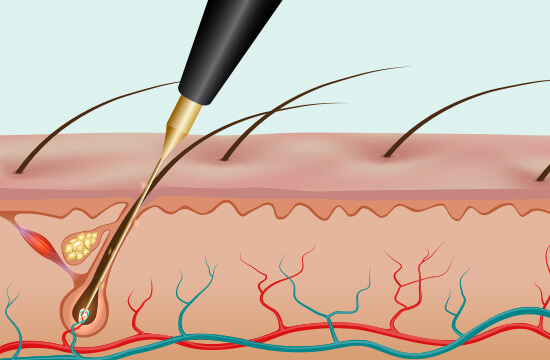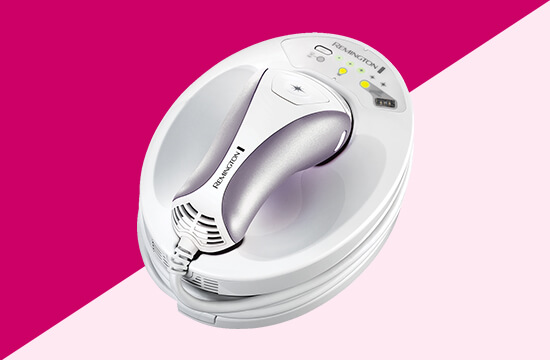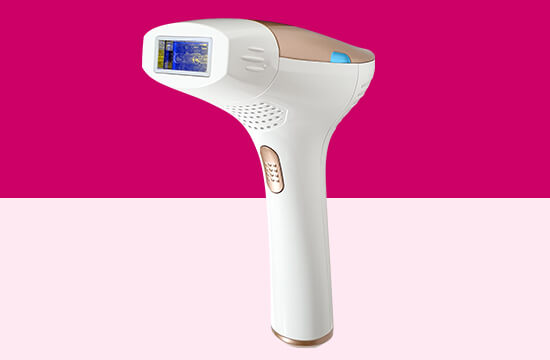
Nothing boosts a feminine look like a smooth, hair-free face.
For crossdressers and transgender women, facial hair removal is often a top priority. From shaving and waxing to depilatories, there are plenty of options to achieve smooth skin.
But when it comes to your face, permanent hair removal is the ultimate goal. This is especially important for those planning a full MTF transition.
So, what’s the best method for removing facial hair permanently? Should you choose electrolysis, laser hair removal, or an a-home device like IPL?
In this blog post, I’ll break down what works for permanent facial hair removal and the pros and cons of each method.
Electrolysis

First and foremost, electrolysis is considered the only TRULY permanent method of hair removal.
It involves inserting a tiny probe into each hair follicle and using electricity to damage the follicle, preventing hair regrowth.
Because each hair must be treated individually, electrolysis is very time consuming.
It also requires more than one treatment per follicle, so you could be looking at years of weekly or bi-weekly appointments.
PROS:
- It’s the only method approved by the FDA for permanent hair removal.
- It’s effective for all skin and hair colors.
CONS:
- It takes many sessions. For example, transgender facial electrolysis averages 70-90 hours all the way up to 300 hours.
- It can be quite painful, especially in areas like the upper lip.
- There’s a risk of skin discoloration or scarring if not performed properly.
COST:
Licensed electrologists charge from $75-$100+ per hour, so the full treatment can add up to thousands of dollars. However, once the hair is gone, it’s gone forever.
Laser Hair Removal – Professional

Laser hair removal is the most popular “permanent” hair removal method, but it’s important to know that it’s only FDA approved for hair REDUCTION.
Laser hair removal uses lasers to damage hair follicles, reducing growth. It can thin the beard by 70%-85%.
Laser hair removal can inhibit hair growth for several years, but some or all of the hair can grow back – especially in people with fair hair.
This means that you may need to have repeat maintenance sessions every 6-12 month.
PROS:
- It can treat large areas at once.
- It’s much faster than electrolysis.
- Most people see a significant reduction in hair growth after 3-8 sessions.
- The hair grows back lighter and finer.
- It’s less painful than electrolysis (though not totally pain-free).
CONS:
- It’s only effective for hair reduction, not 100% hair removal.
- It’s most effective on people with light skin and dark hair. If you have darker skin or fair hair, it will not be as effective.
- There’s a risk of skin discoloration or scarring if not performed properly.
COST:
Laser hair removal costs $50-$400 per area per appointment depending on size. This can also add up to thousands of dollars over the course of the treatment.
You can also check Groupon for deals, but be sure to research the facility carefully. Bargains aren’t always the best idea when it comes to your face and body.
Laser Hair Removal – At Home

With the high cost of laser hair removal, there are now some decent options for doing it yourself. DIY devices can indeed work, but they aren’t without drawbacks.
Here are the pros and cons of at-home laser hair removal:
PROS:
- It offers considerable cost savings over professional treatments.
- It’s more convenient since you don’t have to schedule appointments.
CONS:
- It’s time consuming since at-home devices are smaller than pro devices.
- It’s less effective since at-home devices aren’t as strong.
- It’s hard to treat certain areas (like the back) when you’re treating yourself.
- There’s more risk of side effects since you aren’t a trained pro.
- The devices can be painful to use.
RECOMMENDED DEVICES:
Many of the products marketed as laser hair removal devices are actually IPL devices (described below).
However, the TRIA Beauty Laser Hair Removal Device 4X ($599) uses the same diode laser technology used in-office by dermatologists.
IPL (Intense Pulsed Light)

IPL is similar to laser hair removal, but it uses a different kind of light. Instead of a concentrated laser beam, IPL uses a broader spectrum of light that isn’t as focused.
Because of this, IPL can cover a larger treatment area, but it takes more sessions since the light is less powerful.
Pros:
- Faster than laser hair removal since it covers a larger area.
- Good availability of at-home devices.
- Usually less painful than laser hair removal.
Cons:
- Requires more sessions compared to laser hair removal.
- More risk of irritation due to the broader light spectrum used.
- Can only be used on lighter skin tones / darker hair tones.
RECOMMENDED DEVICES:
Here are some popular and highly rated at-home IPL hair removal devices:
- Braun Silk-Expert Pro 5 IPL Hair Removal System – $303
- Remington iLight Pro Plus Quartz Hair Removal System – $267
- JOVS Venus Pro II Hair Remover – $459
- Silk’n Infinity 400,000 – $399
Let’s talk hair removal
Now that I’ve covered the options for permanent hair removal and reduction, I’d love to hear what YOU think.
Have you tried any of the procedures or products above? If so, what were your results?
Please take my poll and share in the comments below!
Love,
Lucille

P.S. If you liked this article, you will love my FREE Male to Female Transformation Mini Course.




Having been on the outskirts of the trans community for eleven years and an active participant for well over four years, I have learned that the best set up is to start with laser and to move onto electrolysis. At least for me as a person with dark hair.
The reason for this is because the hair that does regrow from laser will be lighter and laser will not be as effective against it, but it will also be thinner. That thinness makes electrolysis that much more effective against it.
And this goes for everyone with dark.
Unfortunately for people with Light hair it would probably be best to go for electrolysis first but that’s probably going to cost a bit more then Laser then Electro.
Several years ago I purchased a Silk’n Flash and Go IPL device. It was quite successful in reducing my leg hairs, which were my focus at that time. I have not been able to find time alone to use it consistently on my face and chest but I do have significant reduction on my chest but my face is still a challenge.
Last year I had to have an ablation done(heart treatment accessed through the groin) and they shaved all my remaining hair near the entry site. Since then I have been shaving to stay smoother. I was only able to be alone in the house a couple of times (the popping noise of the IPL results in too many questions from my non supportive wife) so the level of success there is difficult to judge. If I can consistently find time each week I will get better results. as I did with my legs.
One of the first things I learned from about 6 different laser techs was I am one of the worse candidates for Laser or IPL hair removal because of my pale blonde hair and equally pale Irish skin. The doctor that is handling my HRT gave me a list of the licensed electrolysis techs in the state, and the nearest one is a 100 mile one way drive to her office, so my current choice is door number 3, waxing. Once you start doing it regularly, you only have to wax about 3 times a month, your face essentially remains beard free for most of those 10 days and the hair that grows back is generally thinner, lighter and less noticeable each time. It does take a certain amount of courage to inflict that level of pain on yourself, but like most unpleasant things, it gets easier after some time. If you decide on this choice, I recommend you have it done the first time by a trained pro who can show you how to properly do each section of your face. You also don’t need as much color corrector when you’re nearing the time for your next session.
I new laser hair removal place just opened near me. When I called to check out their offerings, I gave them my age, I figure they can guess the sex I was assigned at birth given my normal voice and assigned name. We talked about current hair color (mostly grey at this point). They responded that the laser does not work on grey hair.
I have a salon by my house that does body sugaring. I love it. They do my entire body, leaving me completely hairless. After completion, when I put on my hosiery, I feel so feminine and sexy. My hair is getting finer and lighter, and they say eventually I won’t need to come in any more.
While I’m not having bottom surgery, my wife had all of my pubic hair permanently removed. She was feminizing me, and felt that the removal of my pubic hair was an essential and dramatically emasculating step.
She had laser done first. A full year of laser did diminish the hair significantly, but it was only temporary. The following year all of it grew back. After that experience, she arranged for genital electrolysis instead.
A competent technician can clear a square inch in about the same time a laser tech requires for treatment of the entire area. It does take about four times as many sessions as laser, but each visit costs much less, so the total expense is actually very similar. If you go once a week, the entire treatment plan is in fact faster than a full course of laser.
The big difference is that electrolysis is utterly reliable. You don’t get the instant gratification that laser provides, but treated hair does not grow back. My tech had at least a 75% success rate on the first pass, two passes and one clean up got everything.
I didn’t find the process unduly painful and did not require numbing cream. The most sensitive spot was the crease between my scrotum and thighs. The taint and scrotum itself were moderate. The penis and mons were very easy, and as a result, were cleared quickly despite the larger area.
My electrolysis was so successful that I’m still bare. In 10 years, I’ve never had more than half a dozen hairs emerge, which I simply pluck out.
While I had my balls done first, I’d suggest starting the the mons. As the largest and easiest area, it quickly makes the most visible difference and is a good warm up for the more sensitive areas. It is important continue beyond the mons though. A properly feminized male should not have any pubic hair.
I’ve read on many bottom surgery informational posts, that permanent hair removal was no longer believed to be necessary.
Then on the other hand, I’ve heard of uncomfortable inward hair growth after surgery. With the high cost of hair removal and pubic hair being coarse and stubbornly resilient, which should you believe or choose. Not to mention the time it would take to become hair free. One might become very old and very poor before meeting the qualifications.
I too have been researching this topic and have found that it is very time consuming and expensive not to mention difficult to get the service professionally done. successful outcomes are difficult to achieve take a great deal of time and effort and aren’t guaranteed with either process. I’m contemplating the idea of purchasing a home use permanent hair removal system but not yet convinced of the safety implications or benefits
I’ve done both laser hair removal on the face and underarms. The underarms hair is half gone and the hormones makes me he rest grow really slowly so I don’t have to shave very often. The facial hair has been reduced and what is gone is gone. But seance the estrogen injections and micronized progesterone lower it enough I can’t take a testosterone blocker any more or anything to stop it from absorbing. So my testosterone levels of normal at 14 it used to be around 4 to 8. But the new difference has caused some of the facial hair to come back.
The electrolysis is for the surgery down there and it’s taking time but what is gone is gone and hasn’t come back. And yes it takes time and costs more. I’m paying 70 an hour plus 35 to have it numbed. It’s allot faster in permanency because of the hair being picked out after it is treated.